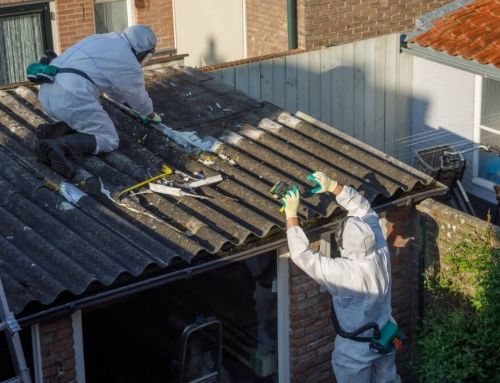
Asbestos, a once-popular building material, is now notorious for its health risks, particularly in older structures where it was extensively used for insulation and fireproofing. An asbestos management survey serves as a critical tool in assessing the presence and condition of asbestos-containing materials (ACMs) in these buildings. By employing meticulous inspection and testing methods, this survey aims to ensure that ACMs are properly managed to prevent airborne contamination during routine building operations or renovations. However, the effectiveness of these surveys depends significantly on various factors, including the surveyor’s expertise and the thoroughness of the survey process. What remains to be examined is how these factors influence the overall safety and compliance of the management strategies that follow. Let’s understand What Is Asbestos Management Survey.
Understanding Asbestos: A Brief Overview
Asbestos, a naturally occurring fibrous mineral, has been utilized in various industries for its resistance to heat, fire, and corrosion. Predominantly mined throughout the 19th and 20th centuries, asbestos fibers are durable, providing significant insulation properties and tensile strength.

However, their microscopic size allows them to be easily airborne and respirable when disturbed, posing severe health risks upon inhalation.
There are six types of asbestos minerals: chrysotile, amosite, crocidolite, tremolite, anthophyllite, and actinolite. Chrysotile, commonly known as white asbestos, constitutes about 95% of asbestos found in buildings in the United States. Each type of asbestos can be identified by its unique fibrous structure and chemical composition, which influence its application and potential health implications.
The hazardous nature of asbestos is linked to several serious diseases, including asbestosis, lung cancer, mesothelioma, and other respiratory conditions. These diseases often manifest years after exposure, making early detection and management crucial.
Due to these health risks, its use has been heavily regulated and, in many cases, banned in construction and other industries. The legacy of asbestos use, however, remains a significant concern, as many older structures still contain these hazardous fibers.
The Purpose of an Asbestos Management Survey
Recognizing the ongoing risks associated with existing asbestos in older buildings, the Asbestos Management Survey serves as a vital tool for property managers and safety professionals. Its primary purpose is to locate, as far as reasonably practicable, the presence and extent of any suspect asbestos-containing materials (ACMs) within a building that could be disturbed or damaged during normal occupancy, including foreseeable maintenance and installation.
This survey is essential not only for maintaining safety but also for complying with legal standards that mandate the management of asbestos in commercial properties.
The survey focuses on assessing the risk posed by ACMs, creating a detailed record that aids in planning any necessary maintenance or construction work that might impact these materials. It provides crucial information that helps in formulating a management plan which includes measures to prevent the disturbance of asbestos and procedures to follow in the event of accidental exposure.
Key Components of an Asbestos Management Survey
An effective Asbestos Management Survey incorporates several critical components designed to ensure comprehensive evaluation and safety.
Firstly, a thorough visual inspection is fundamental. This involves a detailed examination of the premises to identify materials suspected of containing asbestos. The surveyor must access all potential areas, including difficult-to-reach spaces like underfloor cavities and above false ceilings.

Secondly, material assessment is crucial. This component determines the condition of the asbestos-containing materials (ACMs) and assesses their potential for fiber release. Factors considered include the material’s surface treatment, its susceptibility to damage, and its friability — the tendency to crumble under pressure, releasing fibers into the air.
Sampling is another vital component. Strategically collected samples from suspected ACMs are analyzed in accredited laboratories to confirm the presence and type of asbestos fibers. This scientific verification is essential for accurate risk assessment.
Documentation also plays a key role. Comprehensive records of findings, including risk assessments, maps, and photographic evidence, are maintained. These documents provide a basis for developing an asbestos management plan, ensuring all relevant information is accessible for ongoing management and future inspections.
Who Needs an Asbestos Management Survey?
Identifying the need for an Asbestos Management Survey is crucial for owners and managers of buildings constructed before the year 2000. This demographic primarily includes those who operate within non-domestic premises or control the maintenance and repair of a property.
The survey is mandated to ensure that any asbestos-containing materials (ACMs) are identified, managed, and not accidentally disturbed, thereby reducing the risk of exposure to airborne asbestos fibers.
The requirement extends to educational institutions, healthcare facilities, industrial sites, and office buildings, among others. Property managers of rental units, especially residential buildings with common areas, are also obligated to commission these surveys. This is pivotal not only for compliance with health and safety regulations but also for the protection of residents, workers, and visitors from potential asbestos exposure.
Furthermore, during transactions involving older properties, prospective buyers or lessees should insist on an up-to-date Asbestos Management Survey. This precaution safeguards against inheriting unmanaged asbestos risks, which can result in significant remediation costs and legal liabilities.
Therefore, understanding the necessity of this survey is imperative for anyone involved in managing, maintaining, or acquiring older buildings.
The Process: What to Expect During the Survey
When commissioning an Asbestos Management Survey, it is essential to understand the steps and methods involved to ensure thoroughness and compliance with safety standards. Initially, a certified asbestos surveyor or an accredited agency is engaged. They begin by reviewing building plans and maintenance records to identify potential asbestos-containing materials (ACMs) based on historical use and building age.
The survey process involves a systematic physical inspection where accessible areas are carefully examined. For comprehensive coverage, surveyors categorize spaces into management units, focusing on locations likely to contain asbestos, such as older insulation materials, ceiling tiles, and pipe lagging.
Importantly, the survey is non-intrusive, aiming to minimize disturbances while ensuring the safety of building occupants and workers.
Surveyors document their findings meticulously, noting the condition and exact location of ACMs. This includes photographic evidence and detailed descriptions which form a crucial part of the final survey report.
The report also includes risk assessments for identified ACMs and recommendations for managing or remediating these materials, ensuring ongoing safety and compliance with regulatory requirements. This structured approach helps stakeholders make informed decisions regarding asbestos management within their facilities.
Identifying Asbestos: Techniques and Tools Used
Building on the foundational knowledge of the survey process, the next critical step in asbestos management is the accurate identification of asbestos-containing materials. This crucial phase employs a variety of specialized techniques and advanced tools to ensure precise detection and assessment.
One primary method involves sampling materials suspected of containing asbestos and analyzing them using Polarized Light Microscopy (PLM) or Transmission Electron Microscopy (TEM). PLM can determine the presence and category of asbestos fibers by examining their optical properties, while TEM offers a more detailed view, capable of identifying fiber dimensions and morphology at much higher magnifications.
Additionally, X-ray Diffraction (XRD) is utilized to further verify the mineralogical composition of samples, providing conclusive identification of asbestos types. This technique complements the microscopic analyses by confirming the crystalline structure unique to asbestos minerals.
Field professionals also utilize portable infrared spectrometers, allowing for on-site preliminary analyses. This tool helps in quickly distinguishing asbestos from non-asbestos materials through infrared spectral comparison, thus streamlining the survey process.
These methodologies, when combined, furnish a comprehensive and reliable approach to asbestos identification, pivotal for effective management and mitigation strategies in building environments.
Legal Requirements and Compliance
How do legal standards govern asbestos management? The intricate web of regulations surrounding asbestos management is designed to mitigate risks associated with asbestos exposure, ensuring public safety and environmental protection. Compliance with these regulations is not merely advisable; it is mandatory, underpinned by stringent legal obligations that must be rigorously adhered to by property owners, employers, and asbestos professionals.
Key components of legal compliance in asbestos management include:
- Risk Assessments: Mandated evaluations must be conducted to identify the presence and condition of asbestos-containing materials (ACMs). These assessments form the basis for all further actions and are critical in determining the scope of management or remediation required.
- Documentation and Records: Maintaining detailed records of asbestos presence, its condition, and any abatement actions is compulsory. These documents must be accessible to workers, auditors, and regulatory bodies, ensuring transparency and facilitating ongoing management.
- Training and Certification: Individuals involved in asbestos management must undergo certified training. This ensures that those handling ACMs are equipped with the latest safety protocols and techniques, minimizing health risks to themselves and others.
Adhering to these legal standards is essential for compliance and plays a pivotal role in the effective management of asbestos-related hazards.
The Importance of Regular Asbestos Surveys for Safety
Regular asbestos surveys are crucial for maintaining safety in buildings where asbestos-containing materials (ACMs) are present. These surveys serve as systematic evaluations designed to identify the location and condition of ACMs within a structure.

Over time, asbestos, if disturbed or deteriorating, can release fibers into the air, posing severe health risks such as lung cancer, asbestosis, and mesothelioma. Hence, regular surveillance not only helps in assessing the risk of exposure but also ensures compliance with health and safety regulations.
Implementing consistent asbestos surveys facilitates the development of an effective asbestos management plan. This plan is pivotal for outlining procedures for handling ACMs, including maintenance, encapsulation, or removal.
Importantly, the frequency of these surveys depends on various factors such as the age of the building, the presence of friable asbestos, and previous assessment results. Typically, a building should undergo a comprehensive survey at least once every few years or more frequently if significant changes occur, like renovations or damage.
Conclusion
In conclusion, an asbestos management survey is crucial for maintaining safety in environments potentially containing asbestos. This systematic approach not only ensures compliance with legal requirements but also plays a pivotal role in safeguarding public health by preventing inadvertent exposure to asbestos. Regularly conducted, these surveys provide the necessary data to inform effective management and mitigation strategies, thus preserving the integrity of buildings while protecting the health of occupants and workers involved in building maintenance and renovation projects.
About the Author: LandlordCertificate
Related Posts
Get Social
Recent Posts
- Fuse Box Installation: Everything Homeowners Need to Know Before Getting Started
- EICR Certificate London: Understanding Your Legal Duty as an Owner
- Behind the Scenes of a Gas Safety Certificate London Inspection in Homes
- The Role of Fire Alarm Installation in Building Safety
- How Often Should a Fire Risk Assessment Be Reviewed?












